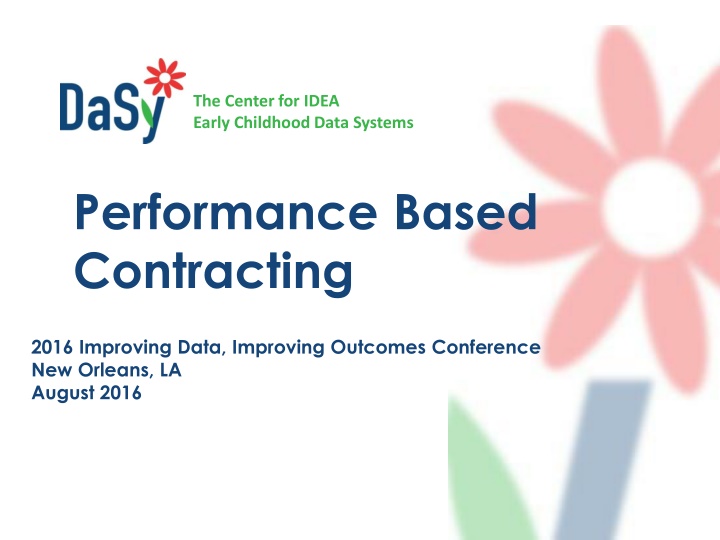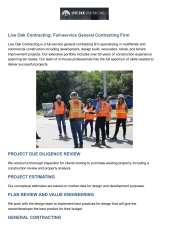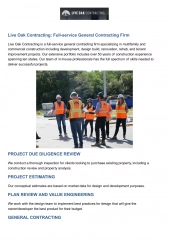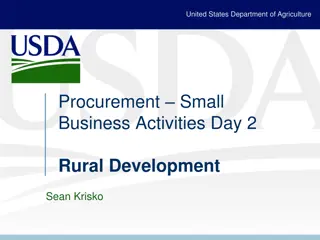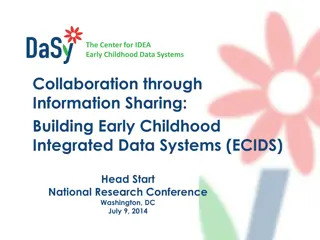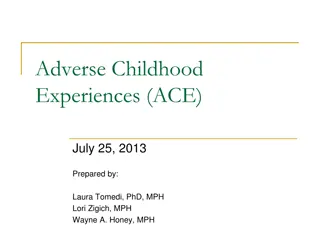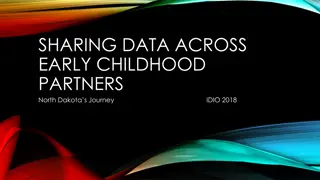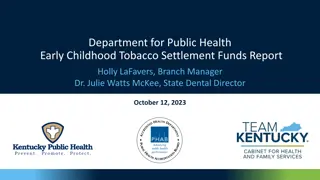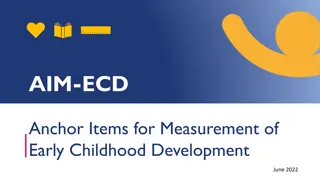Performance-Based Contracting in Early Childhood Services
Performance-Based Contracting is a results-oriented method that ties contractor payments to specific performance standards and outcomes. Explore how Vermont implements this model in delivering early childhood services through a continuum of care.
Download Presentation

Please find below an Image/Link to download the presentation.
The content on the website is provided AS IS for your information and personal use only. It may not be sold, licensed, or shared on other websites without obtaining consent from the author.If you encounter any issues during the download, it is possible that the publisher has removed the file from their server.
You are allowed to download the files provided on this website for personal or commercial use, subject to the condition that they are used lawfully. All files are the property of their respective owners.
The content on the website is provided AS IS for your information and personal use only. It may not be sold, licensed, or shared on other websites without obtaining consent from the author.
E N D
Presentation Transcript
The Center for IDEA Early Childhood Data Systems Performance Based Contracting 2016 Improving Data, Improving Outcomes Conference New Orleans, LA August 2016
Definition Performance Based Contracting is a results-oriented contracting method that focuses on the outputs, quality, or outcomes that may tie at least a portion of a contractor's payment, contract extensions, or contract renewals to the achievement of specific, measurable performance standards and requirements. Source: National Institute of Governmental Purchasing 2
Definition It is a type of contracting with: A clear set of objectives and indicators; Systematic efforts to collect data on the progress of the selected indicators; and Consequences, either rewards or sanctions for the contractor, that are based on performance http://siteresources.worldbank.org/INTHSD/Resources/topics /415176-1216235459918/ContractingEbookSection2.pdf 3
Funding Progression Historic Contracts: provide services with minimal consideration for effectiveness Performance Contracts: measure specific criteria (i.e., outputs, compliance) against identified standards Pay for Success: payment tied to specific criteria, focus on outcomes vs. outputs focus on data and evaluation 4
Vermonts Experience with Performance Contracting Danielle Howes: Part C Coordinator danielle.howes@vermont.gov
Vermont Service Structure Vermont s Part C services are delivered as part of a continuum of early childhood services identified as Children s Integrated Services (CIS) for children and their families prenatally-age 6 including: Nursing Family Support Social Work Part C Early Intervention Early Childhood and Family Mental Health Specialized Child Care Services 6
Vermont Service Structure CIS serves approximately 5,000 children and pregnant women annually (approx. 880 receive Part C services) The State writes 12 contracts annually with regional Visiting Nurse Associations, Parent Child Centers, or Designated Mental and Developmental Health Agencies Contractors bill Vermont s Medicaid system a per- member, per-month rate 7
Performance Based Contracting Since 2010, the State contracts with a single agency in each of our 12 regions to serve as the fiscal agent for all CIS services within the region The fiscal agent subcontracts with other regional agencies to provide all 5 CIS Services Using Results Based Accountability the State: identified 6 contract performance measures with the regional service providers in 2009-2010 New measures were introduced for FY 17 at the request of regional partners 8
Performance Measures Serve To: Measure regional compliance with performance standards Measure quantity and quality of services Support regions and the State in making data- informed decisions Provide meaningful data about service value and the needs of children and families to inform State leadership and legislators 9
Additional Performance Monitoring In addition to Performance Measure Data reported by regional Fiscal Agents, Vermont: Monitors two regions annual for contract compliance Makes regional determinations for Part C Early Intervention Services in accordance with federal regulations and shares determinations with the fiscal agents In all monitoring, the same Quality Improvement Plan expectations are used to support integration 13
Looking to the Future Vermont sees contractors as partners and value working with them to improve the system Vermont developed a position focused on data analysis and quality assurance Vermont is currently recruiting a position to improve consistency and follow-up with contract monitoring Vermont is considering consequences for continued performance issues 14
Missouris Experience with Performance Contracting Pam Thomas: Part C Coordinator pam.thomas@dese.mo.gov
Missouris Part C Program Current Infrastructure Central Finance Office: single entity (est. 2001) Service Providers: sub-contracted/vendors (est. 2002) Service Coordination: 10 regional contracts (est. 2003) Service Delivery: Transdisciplinary teams/PSP (est. 2009) Child Count: Day count of IFSP children 5,388 (12/1/14) FY count of IFSP children 9,628 Total FY count 12,720 (includes all children tested plus IFSP) 16
Missouri Contracts Two Types of Contracts Provider Agreement Signed once at the time of enrollment System Point of Entry (SPOE) Contract Bid for service coordination services every five years 17
Missouris Provider Agreement Purpose Identifies initial and ongoing expectations Establishes activities for provider to maintain an account in good standing Requires procedures for ongoing oversight of the activities Monitoring Accounts (Contractor): Licensure, Background Checks, Liability Insurance, Training Requirements, Availability/SDA Payments (State): Timely Claims, Hours Billed in Single Day, No-Show Visits, Travel Incentive, Reported Billing Issues 18
Missouri SPOE Contract Purpose Initial: Focus on compliance (2002 2008) Intermediate: Focus on service delivery (2008 2014) Current: Shift focus to practices (est. 2014) Monitoring 6 Standards (Liquidated damages): Child count, Timely IFSP data entry, Team assignments, Correction of non- compliance, Complete needs assessment 1 Standard (Incentive): Family Cost Participation fee collection/suspension 19
Lessons Learned Purpose What you identify will get attention will get measured will get done. Be selective in which activities you choose to measure, you cannot select everything! Start with the fundamental or critical pieces. Training/TA is critical for the activities you select, and can range from a few written documents to regular onsite TA. Monitoring Measuring performance in compliance is not the same as measuring practice, they require different approaches to identifying and monitoring contract standards. 21
Illinois: Performance Contracting Evolution Ann Freiburg: Part C Coordinator Ann.Freiburg@illinois.gov
Illinoiss Part C Program Current Infrastructure Central Finance Office: Administrative contract under DHS/EI Service Providers: Provider Agreements, independent or agency based Service Coordination: Staff within 25 Regional Points of Entry Service Delivery: Multidisciplinary Child Count: Day count of IFSP children 15,292 (10/31/15) FY count of IFSP children 21,183 (SFY15/FFY14) Total FY count 34,478 (includes all children tested plus IFSP) 23
Illinois Relationships for EI Services Two Types of Relationships Payee Agreement Signed by Payee (being an agency or an individual) with language of compliance to EI service provision for anyone working under the Payee as a therapy provider. Signed one time and only renewed if changes. System Point of Entry (SPOE) Contract RFP for 5 years GATA impacting length in future Includes Performance Contracting language Base payment is driven by caseload to have Service Coordination. 24
Illinois History of Performance Contracting Illinois created a statewide Early Intervention program in 1991 under state statute. In 2002 we created Performance Contracting for our regional points of entry called Child & Family Connections offices. Original Performance Contract measurements based on three components of system. Participation rate: Find needy children and provide services % of children under 1 in Intake: Find children earlier % of children transitioned to Special Ed: Appropriate services at age 3 25
Illinois Funding with Performance Contracting Quarterly calculation of an annualized amount to pay CFCs. Base caseload size at 43 active IFSPs per Service Coordinator. Ten incentives for performing well. Four penalties for not meeting benchmarks. Have other key components broken down based on caseload as well. Contracted and paid based on quarterly earned amounts compared to allowable expenditures. Direct Service Providers: Work under Payee Agreements, not contracts. Follow all applicable laws, policies and procedures. Paid based on insurance rate (allowable services billed to private insurance) or state rate (based on Medicaid State Plan rate). 26
Illinois: Performance Contracting Calculations Ten incentives: 1% of base grant for having one of the highest 12 CFCs of 25 CFCs percentages: 1. IFSPs initiated before child s first birthday 2. Transition meetings 3. Participation rates for children under 1 4. Natural Environments 5. IFSP completed within 45 days 6. Closure at age 3 to SE or appropriate referral 7. Lowest closures for Family Reasons from Intake 8. Lowest closures for Family Reasons from IFSP 9. Lowest cases with older infants/toddlers (2.5+) 10.Lowest days between referral to IFSP 27
Illinois: Performance Contracting Calculations (Continued) Four Penalties: 1. Insufficient staffing value of missing staff. 2. 1% of base for cases over 45 days with no IFSP if over 5% of # from past; 2% if exceed 7.5%. 3. 1% if less than 85% of children have services predominantly in natural environments. 4. 1% if average age of new children exceeds 630 days old and 2% if over 640 days. 28
Illinois: Above Performance Contracting Annualized calculation of payments also includes: Local Interagency Council Coordination: Minimum grant of $19,000 plus extra $3,000 per LIC Parent Liaison Activities: Minimum grant of $19,000 and maximum grant of $76,000 based on caseload Developmental Pediatric Consultation: Funding to contract for specialized consultation based on $88.90 per active case Social Emotional Consultation: Minimum grant of $37,500 and maximum grant of $100,00 based on caseload Plus $3,000 to fund extra services of SE function 29
Illinois: Performance Contracting History $29,848,523 $28,961,324 $26,320,808 Baseline $25,320,363 $22,276,548 $21,397,782 Incentives & Penalties Total CFC Earned Admin Contracts $6,647,877 $6,279,327 $4,552,887 $1,000,445 $887,199 $878,766 FFY15 FFY10 FFY05 30
Illinois: Time to Evolve/Lessons Learned SSIP focus on Results Driven Accountability State focus on Return on Investment Illinois EI focus on SiMR 32
Questions 33
For more information: Visit the DaSy website at: http://dasycenter.org/ Like us on Facebook: https://www.facebook.com/dasycenter Follow us on Twitter: @DaSyCenter 34
The contents of this presentation were developed under a grant from the U.S. Department of Education, # H373Z120002. However, those contents do not necessarily represent the policy of the U.S. Department of Education, and you should not assume endorsement by the Federal Government. Project Officers, Meredith Miceli and Richelle Davis. 35
